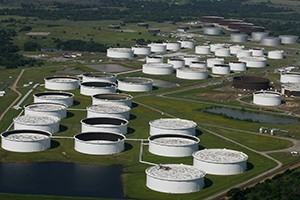Check out the most recent edition of the Energy Institute newsletter!
Dynamics of Arbitrage
Co-authored by Louis Ederington, Chitru Fernando and Scott Linn (Price College of Business, University of Oklahoma), Kateryna Holland (Trulaske College of Business, University of Missouri) and Thomas Lee (Energy Information Administration, U.S. Department of Energy) (Journal of Financial and Quantitative Analysis, 2020)

Oil storage tanks pictured in Cushing, OK. Tulsa World Photo
Futures contracts for oil and natural gas and the associated futures prices, play an active and important role in the management of energy companies. Distortions of these futures prices have implications for risk management and investment activity.
Futures prices and the spot prices for oil stay in tune through the actions of producers and traders through a process generally referred to as cash-and-carry arbitrage. When irregularities between futures and spot prices arise, such trading brings them back in line.
This however can require buying oil and storing that oil for later use. The primary storage location for such trades is Cushing, Oklahoma, the delivery point for oil futures contracts traded on NYMEX. An important ingredient for ensuring that irregularities in futures prices is at worst short-lived, is that storage capacity is available.
The authors find that inventory movements associated with arbitrage trading occur at Cushing, but not at other storage locations where, instead, operational factors explain most inventory changes. Importantly the authors find that storage capacity limits can impede arbitrage, leading to the persistence of distortions between spot and futures prices, but that in general arbitrage-induced inventory movements in the oil market on average act to stabilize prices.
The evidence presented overwhelmingly indicates that storage constraints can lead to persistent irregularities in futures and potentially spot oil prices.
OU faculty, staff and students click here to access the paper. All others, click here.


